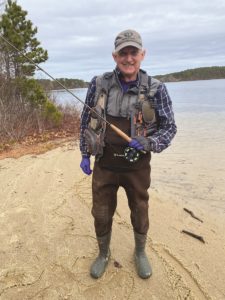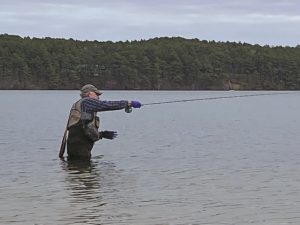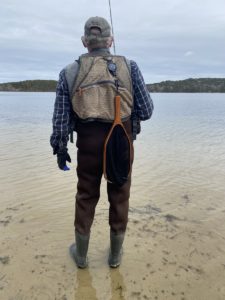Friends recently asked me what I fish for during the winter months. It was the evening of our odd one-day cold snap, and we were sitting around slurping fresh oysters and clams and carving up a slab of freshly smoked steelhead trout.
“These I dug up in Chipman’s Cove,” I said, pointing to the plate of shellfish. “And this,” I added, pointing towards the smoked trout, “I caught at Costco.”

Recreational winter fishing on the Outer Cape is now, unfortunately, mostly limited to the months when stripers, blues, mackerel, flounder, and other warmer-water species fill the harbors, bays, beaches, and inlets along our shorelines. The only exception is that in our state-stocked kettle ponds, on warmer-than-average winter days, trout can be fished without fear of frozen fingers.
On those rare days when the sun is bright and the wind is light from the southwest, I’m one of those who heads to Gull Pond in Wellfleet wearing thick neoprene waders, a wool hat, and fingerless gloves pulled over latex ones to keep my hands dry. There, casting flies for sluggish rainbow trout is a welcome reprieve from daydreaming about a striper run that’s still two long months away.
The deep, clear bodies of water that dot the length of this peninsula were formed by enormous blocks of ice shed by the last receding glacier. The icebergs stood grounded on what was then the sea bottom and remained anchored in place while the departing glacier slowly filled the spaces around them with the outpouring of pebbles, sand, and silt in the meltwater from beneath the ice.

While cold-loving trout have a hard time surviving the hot summer in shallower ponds, the deeper kettles — Gull Pond is 90 feet deep — sustain trout all year round. Even these deep ponds must be regularly stocked, because rainbow and brown trout need fast-moving streambeds to reproduce. But their ability to survive for years means the ponds are full of “holdover” fish, which are larger, more brightly colored, feistier, and far tastier than trout fresh from the hatchery. You don’t catch one often, but when you do, it’s a banner day.
There is some irony in the fact that these lovely ponds, formed during the planet’s last globe-changing warming period 17,000 years ago, are the Cape’s only remaining winter gamefish environment in the newest climate-warming epoch. But not all the blame for the lack of winter fishing on Cape Cod is the result of climate change. Before they were nearly wiped out by commercial fishing, cod could be caught in late winter and early spring off our beaches. Tidal streams like the Pamet and Herring rivers were full of late-fall and early-spring runs of brook trout called “salters,” for which Cape Cod was famous. On many older Cape maps, the large tidal stream south of Blackfish Creek is variously labeled Salter Creek and Trout Brook rather than Fresh Brook, the name it bears today. Wellfleet’s sea-run brookies were so famous President Grover Cleveland is said to have cast his flies for them.

These weren’t the only fish available to Cape Codders in the colder months. Winter flounder were plentiful, as were winter runs of whiting, which were called “frostfish” because they often froze solid a few minutes after they were caught from local piers.
Not all of this is ancient history. Runs of smelts blessed the local tidal rivers in winter months into the 1950s. And in the 1970s, when I lived on the Cape year-round, the kettle ponds still provided good fishing. When the ice came — it usually formed the last week of November or the first 10 days of December — we would go into our cellars and garages and clean up our hockey gear, sharpen our skates, and enjoy days of clean black ice before sleet and snow made the pond surfaces unplayable. Then we would return to our sports hidey-holes and pull out our buckets of tip-ups. These were little gizmos consisting of a crude fishing reel and a spring-loaded wire with a red flag at its tip, all mounted on a crossed pair of sticks supporting the apparatus over a hole chopped into the ice. Our gear included mummichog traps, which we deployed in easily accessible tidal areas to provide us with live bait.

Every time I wade out into the cold pond water, I remember those days out on the ice, where we would drop a mummichogged hook wherever we thought a semi-somnolent trout might be lurking. I recall bringing our beach chairs to the ponds. We would lug sleds loaded with firewood and make full days of waiting for our flags to snap to attention signaling a feeding fish. We didn’t need coolers for our beer or leashes for our dogs, and, on lucky days, a hunter might provide a slab of salted deer ribs to roast next to the flames. All the while, we’d merrily yak about the wonderful fishing that lay just ahead on the calendar.
I also recall how the old-timers would reminisce about how much better the fishing was back in their day. Proof, perhaps, of French writer Jean-Baptiste Alphonse Karr’s oft-repeated line, “The more things change, the more they stay the same.”



